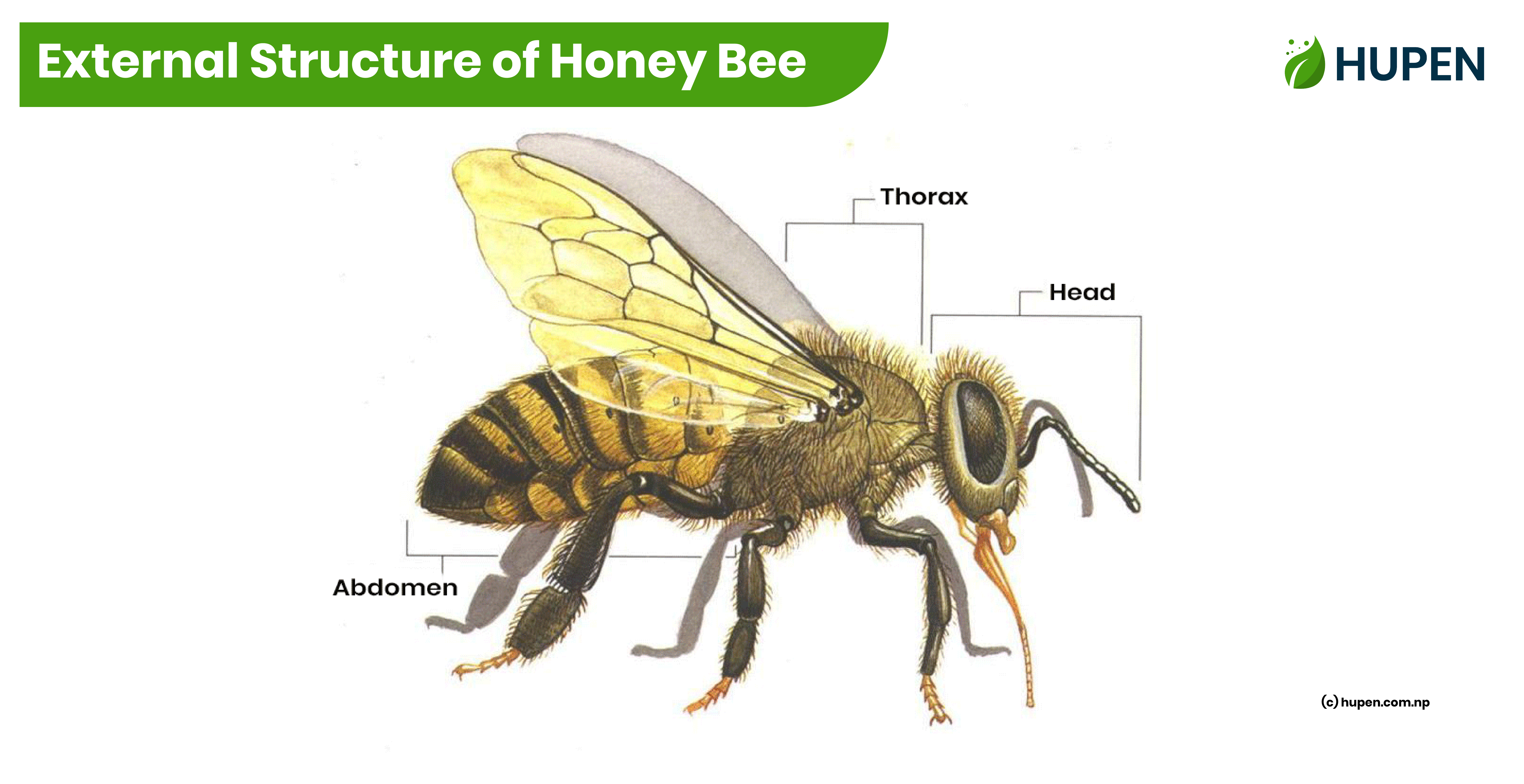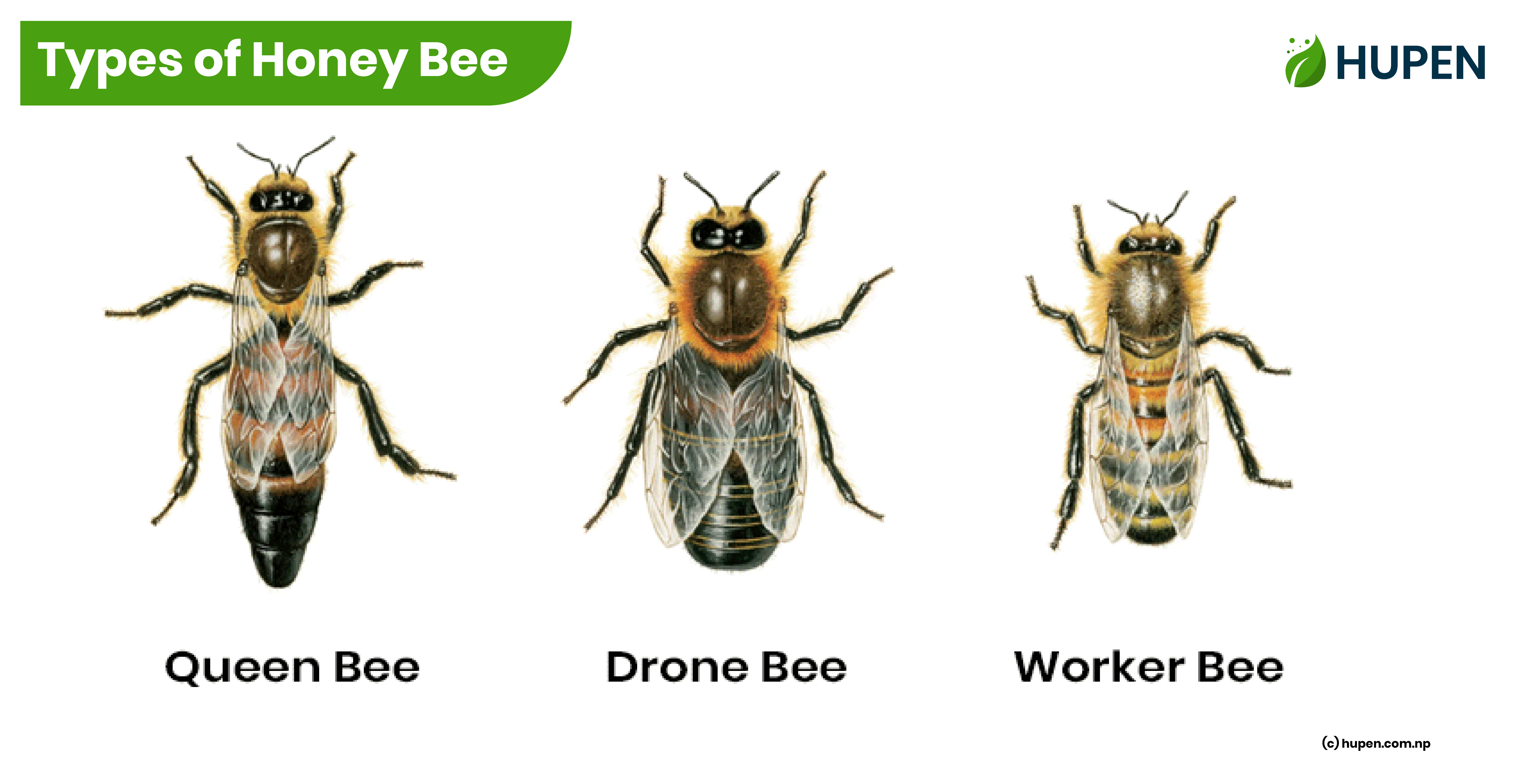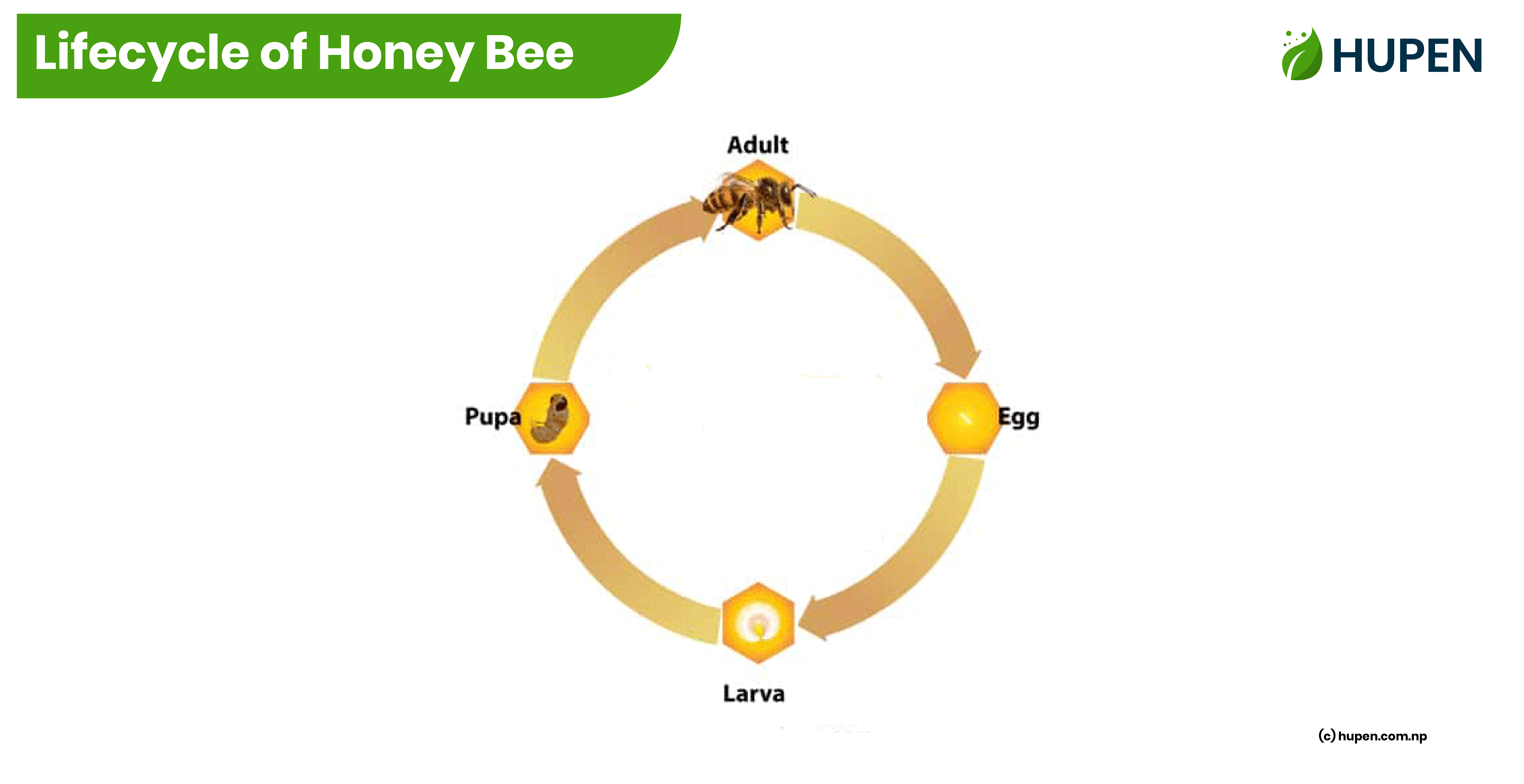
Introduction of Honey Bee
The honey bee is a very useful insect to human beings. Honey bees are flying social insects. They tend to live in a colony. They produce and store honey. It belongs to the phylum Arthropoda of invertebrates. The generic name of the honey bee is Apis. Apis mellifera and Apis cerana are the only honey-producing bees known in Nepal.
Apiculture: The process of professional beekeeping or bee farming is called Apiculture.
Apicology/Melittology: The field of study that focuses on honey bees is called Apicology or Melittology.
External Structure of Honey Bee

The general external structure of honey bees is as follows.
- They have a hard outer shell called an exoskeleton.
- They have three main body parts: the head, thorax, and abdomen.
- They have a pair of antennae that are attached to their head.
- They have three pairs of legs used for walking.
- They have two pairs of wings.
Types of Honey Bee
There are three types of honey bees. They are Queen Bee, Drone Bee, and Worker Bee.

1. Queen Bee:
The characteristics of Queen Bee are as follows.
- It is the largest bee in a bee hive.
- There is only one queen bee in a bee hive.
- Its lifespan is about 2 to 5 years.
- It controls other bees and systemize the bee hive.
- Its main work is to lay eggs.
2. Drone Bee:
The main characteristics of Drone Bee are as follows.
- It is smaller than queen bee but larger than worker bee.
- It doesn’t have sting gland, pollen basket and honey producing gland.
- Its lifespan is about 2 months.
- Its main works are to fertilize the queen bee and to keep the hive warm.
3. Worker Bee:
The main characteristics of Worker Bee are as follows.
- It is the smallest bee in a bee hive.
- It does have sting gland, pollen basket, was glands, and honey producing glands.
- Its lifespan is about 6 weeks to 6 months.
- Its main works are to protect beehive, to collect sap from followers, to take care larvae and to build honey comb.
Lifecycle of Honeybee
The Queen attends a nuptial flight with several drones for mating. Then, the queen returns back to the hive carrying sperm in sperm sacs or spermathecae. The queen begins laying eggs in inside the brood cell. The lifecycle of a honeybee is completed in four major phages, egg, larva, pupa, and adult. In the lifecycle of the honeybee, the process of the old tissue being destroyed (histolysis) and new tissue being developed (histogenesis) happens continuously which is called complete metamorphosis.

1. Egg: This is the first stage. A queen lays about 3000 eggs per day. The eggs are white in color and elongated in shape with size about 1mm to 1.5 mm. Eggs take about 3 days to hatch into larvae.
Note: The queen is able to lay unfertilized eggs, which will become drone bee and fertilized eggs, which will become worker bee or new generations of queens.
2. Larva: The newly hatched larva is almost microscopic in size without legs and eyes. Larva is fed on died known as royal jelly for initial three days. As the third day progresses larvae that are destined to develop into queen bees continue on royal jelly, while worker larvae and drone larvae fed on honey, water and pollens. Larval stage for queen bee lasts for 5.5 days, 6 days for worker and 7 days for drone bees.
3. Pupa: Each larva spins itself a cocoon and becomes pupa. Reorganization of tissues massively takes place during pupal stage. Worm-like body has now three distinct parts of the body. This stage usually lasts for 7.5 days for queen, 12 days for worker and 14 days for drone bees.
4. Adult: After undergoing a series of successive transformations, the pupa undergoes a metamorphosis and emerges as an adult. The upper layer of wax in the brood cells is removed by the bee using its mandible, which is located in its mouth, allowing it to exit the cell.
Time duration for the completion of lifecycle:
| SN | Type of Bee | Egg | Larva | Pupa | Total Time |
| 1 | Queen | 3 days | 5.5 days | 7.5 days | 16 days |
| 2 | Worker | 3 days | 6 days | 12 days | 21 days |
| 3 | Drone | 3 days | 7 days | 14 days | 24 days |
Division of work in Honey Bee
| SN | Type and age | Functions |
| 1 | Drone Bee | To fertilize the queen and to keep the hive warm. |
| 2 | Queen Bee | To lay eggs, to control and systemize the hive by releasing special odor. |
| 3 | Worker Bee | |
| 1-3 days | To give warmth to eggs, larva and pupa, to clean cells. | |
| 4-6 days | To feed larva. | |
| 7-11 days | To feed royal jelly to the larva and queen bee. | |
| 12-17 days | They secrete wax from 4 pairs of wax glands and build a honey comb with that wax. | |
| 18-20 days | To protect the beehive from enemies. | |
| 21 days | To collect nectar, pollens, Sap and water. | |
Importance of honeybee
The advantages of Honey Bee are as follows:
- Honey bees produce honey, which contains enzymes, vitamins, water, and minerals.
- Bee wax is used to make candles and cosmetic products.
- Apiculture helps to improve the economic conditions of farmers.
- Honey bee helps in pollination.
Advantages of Honey
The advantages of Honey are as follows:
- Honey is rich in vitamins and functions as an anti-oxidant.
- Honey is good for keeping the skin healthy.
- Honey helps strengthen the immune system.
- Honey helps to prevent heart disease, diabetes, and hair loss.
Share Now
Share to help more learners!

